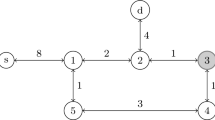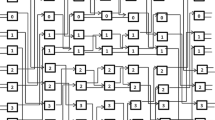Abstract
The popularity of broadband streaming applications requires communication networks to support high-performance multicasting at the optical layer. Suffering from transmission impairments in multi-hop all-optical (transparent) WDM multicasting networks, the signal may be degraded beyond the receivable margin at some multicast destinations. To guarantee the signal quality, we introduce a translucent WDM multicasting network to regenerate the degraded signals at some switching nodes with electronic 3R (reamplification, reshaping and retiming) functionality. The translucent network is built by employing three kinds of multicasting capable switching architectures: (1) all-optical multicasting capable cross connect (oMC-OXC), (2) electronic switch and (3) translucent multicasting capable cross connect (tMC-OXC). Among them both the electronic switch and tMC-OXC are capable of electronic 3R regeneration. Furthermore, we propose a multicast-capable nodes placement algorithm based on regeneration weight, and two multicasting routing algorithms called nearest hub first and nearest on tree hub first to provide signal-quality guaranteed routes for the multicasting requests. The numerical simulation on two typical mesh networks shows that it is sufficient to equip 30% of the nodes or less with signal-regeneration capability to guarantee the signal quality.
Similar content being viewed by others
References
Eckert, T., Rosen, E.C., Aggarwal, R., Rekhter, Y.: MPLS multicast encapsulations. IETF draft, draft-rosen-mpls-multicast-encaps-00 (April 2005).
Rosen, E.C., Viswanathan, A., Callon, R.: Multiprotocol label switching architecture. IETF RFC 3031 (January 2001).
Delange O.E. (1970). Wide-band optical communication systems. Part II. Frequency-division multiplexing. Proc. IEEE 58(10): 1683–1690
Borella, M.S., Mukherjee, B.: A reservation-based multicasting protocol for WDM local lightwave networks. In: Proceedings of the IEEE ICC 1995, vol. 2, pp. 1277–1281, Seattle, WA, USA (June 1995).
Maier M., Scheutzow M., Reisslein M. (2003). The arrayed-waveguide grating-based single-hop WDM network: an architecture for efficient multicasting. IEEE J. Sel. Areas Commun. 21(9): 1414–1432
Rouskas G.N. (2003). Optical layer multicast: rationale, building blocks, and challenges. Network IEEE 17(1): 60–65
Malli, R., Zhang, X., Qiao, C.: Benefit of multicasting in all- optical networks. In: SPIE Proceedings of Conference, All-optical Networking, vol. 3531, pp. 209–220 (November 1998).
Hu W., Zeng Q. (1998). Multicasting optical cross connects employing splitter-and-delivery switch. IEEE Photon. Technol. Lett. 10, 970–972
Ali M., Deogun J. (2000). Power-efficient design of multicast wavelength-routed networks. IEEE J. Sel. Areas Commun. 18(10): 1852–1862
Sun, W., Jin, Y., Hu, W. et al.: Prototype demonstration of IP multicasting over optical networks with dynamic point-to-multipoint configuration, Proceedings of the OFC 2005, vol. 3, pp. 133–135, Anaheim, USA (March 2005).
Pan, Z., Yang, H., Zhu, Z., Ben Yoo, S.J.: Experimental demonstration of a multicast-capable optical-label switching router, Proceedings of the OFC 2005, vol. 2, pp. 64–66, Anaheim, USA (March 2005).
Yang X., Ramamurthy B. (2005). Sparse regeneration in translucent wavelength-routed optical networks: architecture, network design and wavelength routing. Photonic Netw. Commun. 10(1): 39–53
Shen G., Grover W.D., Cheng T.H., Bose S.K. (2002). Sparse placement of electronic switching nodes for low blocking in translucent optical networks. OSA J. Opt. Netw. 1(12): 424–441
Wu, K., Wu, J., Yang, C.: Multicast routing with power consideration in sparse splitting WDM networks. IEEE ICC 2001, vol. 2, pp. 513–517, Helsinki, Finland (June 2001).
Hamad, A.M., Kamal, A.E.: Optimal power-aware design of all-optical multicasting in wavelength routed networks. Proceedings of the IEEE ICC 2004, vol. 3, pp. 20–24, Paris, France (June 2004).
Xin, Y., Rouskas, G.N.: Multicast routing under optical layer constraints, Proceedings of the IEEE INFOCOM, pp. 2731–2742, Hong Kong, China (March 2004).
Ali M., Deogun J.(2000). Allocation of splitting nodes in all-optical wavelength-routed networks. Photonic Netw. Commun. 2(3): 247–265
Zhang X., Wei J.Y., Qiao C. (2000). Constrained multicast routing in WDM networks with sparse light splitting. IEEE/OSA J. Lightwave Technol. 18, 1917–1927
Sreenath N., Ram Murthy C.S., Mohan G. (2001). Virtual source based multicast routing in WDM optical networks. Photonic Netw. Commun. 3(3): 213–226
Author information
Authors and Affiliations
Corresponding author
Rights and permissions
About this article
Cite this article
Peng, Y., Hu, W., Sun, W. et al. Impairment constraint multicasting in translucent WDM networks: architecture, network design and multicasting routing. Photon Netw Commun 13, 93–102 (2007). https://doi.org/10.1007/PL00022065
Published:
Issue Date:
DOI: https://doi.org/10.1007/PL00022065




